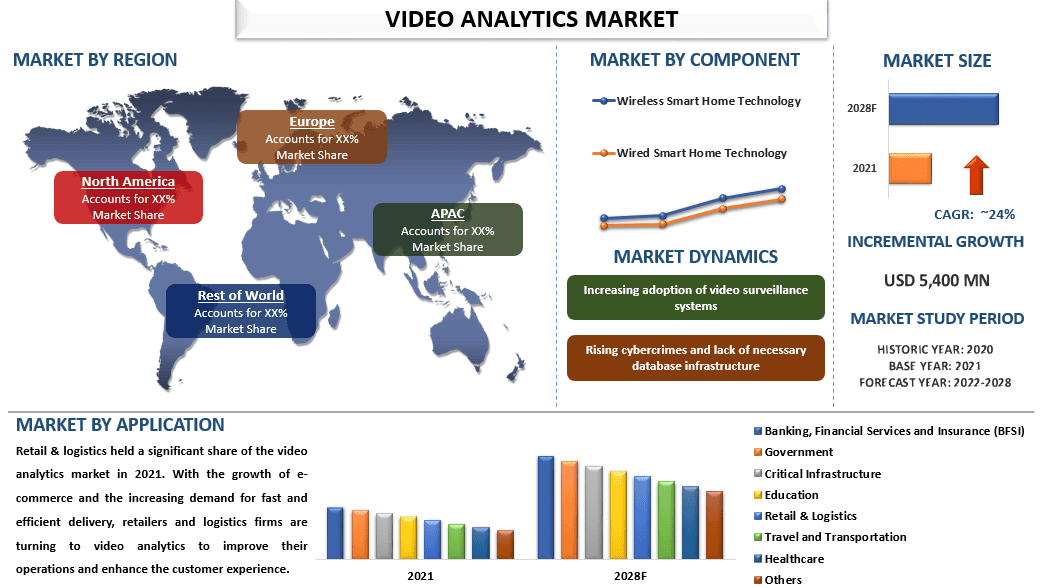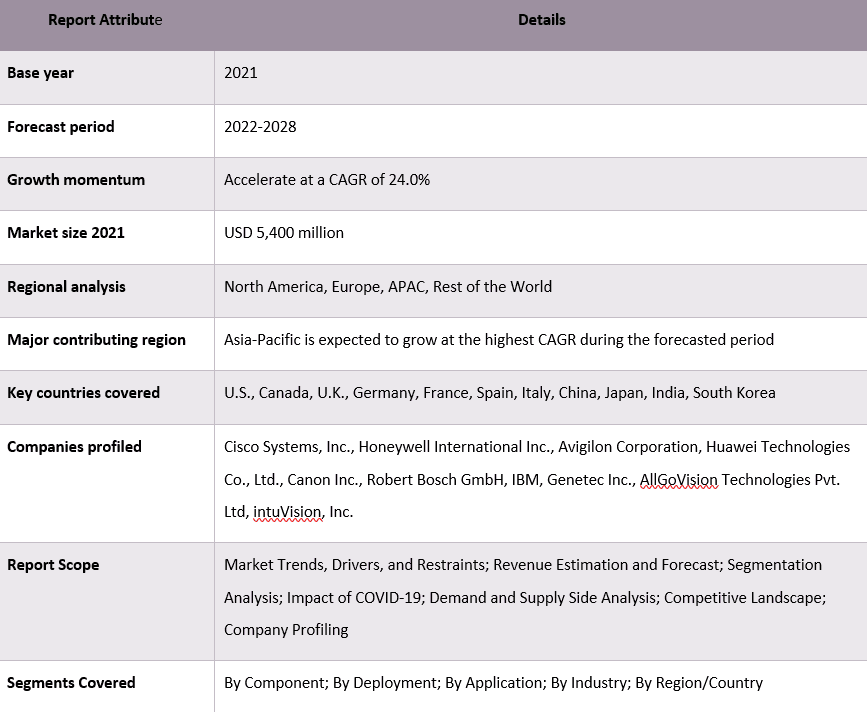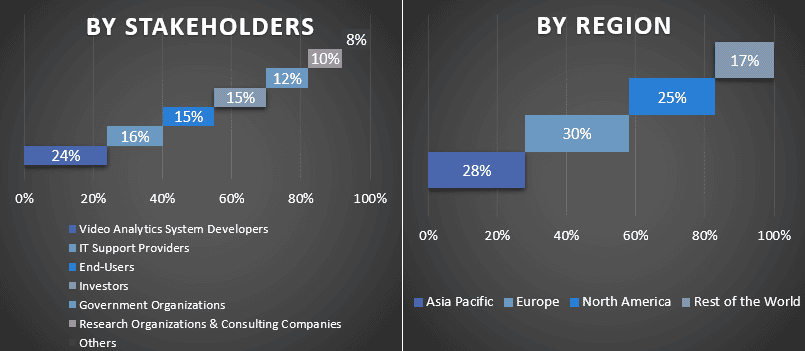- Accueil
- À propos de nous
- Industrie
- Services
- Lecture
- Contactez-nous
Marché de l'analyse vidéo : Analyse actuelle et prévisions (2022-2028)
Accent sur les composants (logiciels, services) ; Déploiement (sur site, cloud) ; Application (gestion de la foule, reconnaissance faciale, détection d’intrusion, reconnaissance de plaques d’immatriculation, détection de mouvement et autres) ; Secteur (BFSI, gouvernement, infrastructure critique, éducation, commerce de détail et logistique, voyages et transports, soins de santé et autres) ; et Région/Pays

La valeur du marché de l'analyse vidéo était de 5 400 millions de dollars américains en 2021 et devrait croître à un TCAC de 24 % de 2022 à 2028. L'analyse vidéo peut être utilisée pour extraire des informations significatives des séquences vidéo, telles que l'identification des personnes, des objets et des événements en temps réel, et a connu une croissance importante ces dernières années. Cette croissance a été stimulée par les avancées technologiques, telles que l'apprentissage automatique et la vision par ordinateur, ainsi que par une demande croissante d'informations basées sur la vidéo dans tous les secteurs. De plus, avec une sensibilisation accrue au besoin et aux avantages de la technologie d'analyse vidéo, les dépenses en développement de produits et en activités de R&D ont augmenté dans le monde entier. En outre, l'augmentation des investissements et des lancements de produits sur le marché de l'analyse vidéo contribuent également à la croissance du marché. Par exemple, en avril 2020, Bosch a annoncé le lancement d'INTEOX, une nouvelle plateforme de caméras qui devrait changer le secteur de la sécurité et de la sûreté. Première plateforme entièrement ouverte du genre, INTEOX offre aux utilisateurs, aux intégrateurs de systèmes et aux développeurs d'applications une liberté sans précédent en matière d'innovation et de personnalisation.
Parmi les principaux acteurs opérant sur le marché figurent Cisco Systems, Inc., Honeywell International Inc., Avigilon Corporation, Huawei Technologies Co., Ltd., Canon Inc., Robert Bosch GmbH, IBM, Genetec Inc., AllGoVision Technologies Pvt. Ltd, intuVision, Inc. Plusieurs fusions et acquisitions ainsi que des partenariats ont été entrepris par ces acteurs pour faciliter l'accès des clients à des produits/technologies de pointe et innovants.
Aperçus présentés dans le rapport
« Parmi les applications, la gestion des foules détenait une part importante en 2021 »
Selon l'application, le marché est segmenté en gestion des foules, reconnaissance faciale, détection d'intrusion, reconnaissance des plaques d'immatriculation, détection de mouvement et autres. La gestion des foules détenait une part importante en 2021. La gestion des foules dans l'analyse vidéo est un outil puissant qui peut aider les organisateurs d'événements, les forces de l'ordre et d'autres organisations à assurer la sécurité et le contrôle des foules. Ainsi, les facteurs mentionnés ci-dessus stimulent le segment.
« Parmi les industries, la technologie d'analyse vidéo sans fil détenait la part majoritaire du marché en 2021 »
Par secteur, le marché est segmenté en services bancaires, services financiers et assurances (BFSI), gouvernement, infrastructures critiques, éducation, vente au détail et logistique, voyages et transports, soins de santé et autres. Les services bancaires, les services financiers et les assurances (BFSI) devraient croître à un TCAC important au cours de la période de prévision. Ceci est largement utilisé pour améliorer la sécurité et la surveillance, détecter les activités frauduleuses, améliorer le service à la clientèle, assurer la conformité aux réglementations et améliorer l'efficacité opérationnelle.
« L'Asie-Pacifique croît à un TCAC important au cours de la période de prévision »
L'Asie-Pacifique devrait croître à un TCAC important au cours de la période de prévision. Cela est principalement attribuable à l'adoption croissante de systèmes de vidéosurveillance et au besoin croissant de solutions d'analyse vidéo intelligentes pour améliorer la sécurité et l'efficacité opérationnelle. De plus, la croissance du marché de l'analyse vidéo dans la région Asie-Pacifique est stimulée par des facteurs tels que les préoccupations croissantes en matière de sécurité, un besoin croissant d'efficacité opérationnelle et les progrès technologiques tels que l'IA et l'apprentissage automatique. Selon un rapport de Numbeo, en 2023, qui compare les taux de criminalité dans différents pays, plusieurs pays de la région Asie-Pacifique ont des taux de criminalité plus élevés que la moyenne mondiale, notamment l'Afghanistan, la Syrie et le Bangladesh.

Raisons d'acheter ce rapport :
- L'étude comprend une analyse de la taille et des prévisions du marché validée par des experts clés authentifiés du secteur.
- Le rapport présente un aperçu rapide de la performance globale de l'industrie en un coup d'œil.
- Le rapport couvre une analyse approfondie des pairs de l'industrie de premier plan en mettant l'accent sur les principaux éléments financiers de l'entreprise, les portefeuilles de produits, les stratégies d'expansion et les développements récents.
- Examen détaillé des moteurs, des contraintes, des principales tendances et des opportunités qui prévalent dans l'industrie.
- L'étude couvre de manière exhaustive le marché dans différents segments.
- Analyse approfondie au niveau régional de l'industrie.
Options de personnalisation :
Le marché mondial de l'analyse vidéo peut être davantage personnalisé selon les exigences ou tout autre segment de marché. De plus, UMI comprend que vous pouvez avoir vos propres besoins commerciaux, alors n'hésitez pas à communiquer avec nous pour obtenir un rapport qui correspond parfaitement à vos besoins.
Table des matières
Méthodologie de recherche pour l'analyse du marché de l'analyse vidéo (2022-2028)
L'analyse du marché historique, l'estimation du marché actuel et la prévision du marché futur du marché mondial de l'analyse vidéo ont été les trois principales étapes entreprises pour créer et analyser l'adoption de l'analyse vidéo dans les principales régions du monde. Une recherche secondaire exhaustive a été menée pour collecter les chiffres du marché historique et estimer la taille actuelle du marché. Deuxièmement, pour valider ces informations, de nombreuses conclusions et hypothèses ont été prises en compte. De plus, des entretiens primaires exhaustifs ont également été menés avec des experts de l'industrie tout au long de la chaîne de valeur du marché mondial de l'analyse vidéo. Après la prise d'hypothèses et la validation des chiffres du marché par le biais d'entretiens primaires, nous avons utilisé une approche descendante/ascendante pour prévoir la taille complète du marché. Par la suite, des méthodes de ventilation du marché et de triangulation des données ont été adoptées pour estimer et analyser la taille du marché des segments et sous-segments de l'industrie concernée. Une méthodologie détaillée est expliquée ci-dessous :
Analyse de la taille du marché historique
Étape 1 : Étude approfondie des sources secondaires :
Une étude secondaire détaillée a été menée pour obtenir la taille du marché historique du marché de l'analyse vidéo à partir de sources internes à l'entreprise telles que les rapports annuels et les états financiers, les présentations de performance, les communiqués de presse, etc., et de sources externes, notamment les journaux, les actualités et les articles, les publications gouvernementales, les publications des concurrents, les rapports sectoriels, les bases de données tierces et autres publications crédibles.
Étape 2 : Segmentation du marché :
Après avoir obtenu la taille du marché historique du marché de l'analyse vidéo, nous avons mené une analyse secondaire détaillée pour recueillir des informations sur le marché historique et la part des différents segments et sous-segments pour les principales régions. Les principaux segments inclus dans le rapport sont les composants, le déploiement, l'application et l'industrie. Des analyses plus approfondies au niveau des pays ont été menées pour évaluer l'adoption globale des modèles de test dans cette région.
Étape 3 : Analyse des facteurs :
Après avoir acquis la taille du marché historique des différents segments et sous-segments, nous avons mené une analyse des facteurs détaillée pour estimer la taille actuelle du marché de l'analyse vidéo. De plus, nous avons mené une analyse des facteurs à l'aide de variables dépendantes et indépendantes telles que les composants, le déploiement, l'application et l'industrie du marché de l'analyse vidéo. Une analyse approfondie a été menée pour les scénarios de l'offre et de la demande en tenant compte des principaux partenariats, fusions et acquisitions, expansion commerciale et lancements de produits dans le secteur du marché de l'analyse vidéo à travers le monde.
Estimation et prévision de la taille actuelle du marché
Taille actuelle du marché : Sur la base des informations exploitables tirées des 3 étapes ci-dessus, nous sommes parvenus à la taille actuelle du marché, aux principaux acteurs du marché mondial de l'analyse vidéo et aux parts de marché des segments. Tous les pourcentages de parts requis, les répartitions et les ventilations du marché ont été déterminés à l'aide de l'approche secondaire susmentionnée et ont été vérifiés par le biais d'entretiens primaires.
Estimation et prévision : Pour l'estimation et la prévision du marché, des pondérations ont été attribuées à différents facteurs, notamment les moteurs et les tendances, les contraintes et les opportunités disponibles pour les parties prenantes. Après avoir analysé ces facteurs, les techniques de prévision pertinentes, c'est-à-dire l'approche descendante/ascendante, ont été appliquées pour parvenir à la prévision du marché pour 2028 pour différents segments et sous-segments sur les principaux marchés à l'échelle mondiale. La méthodologie de recherche adoptée pour estimer la taille du marché comprend :
- La taille du marché de l'industrie, en termes de revenus (USD) et le taux d'adoption du marché de l'analyse vidéo sur les principaux marchés nationaux
- Tous les pourcentages de parts, les répartitions et les ventilations des segments et sous-segments du marché
- Les principaux acteurs du marché mondial de l'analyse vidéo en termes de produits offerts. De plus, les stratégies de croissance adoptées par ces acteurs pour concurrencer sur le marché en croissance rapide
Validation de la taille et de la part du marché
Recherche primaire : Des entretiens approfondis ont été menés avec les principaux leaders d'opinion (KOL), notamment les cadres supérieurs (CXO/VP, chef des ventes, chef du marketing, chef des opérations, chef régional, chef de pays, etc.) dans les principales régions. Les conclusions de la recherche primaire ont ensuite été résumées et une analyse statistique a été effectuée pour prouver l'hypothèse énoncée. Les données issues de la recherche primaire ont été consolidées avec les conclusions secondaires, transformant ainsi l'information en informations exploitables.
Répartition des participants primaires dans différentes régions

Ingénierie du marché
La technique de triangulation des données a été utilisée pour achever l'estimation globale du marché et pour parvenir à des chiffres statistiques précis pour chaque segment et sous-segment du marché mondial de l'analyse vidéo. Les données ont été divisées en plusieurs segments et sous-segments après avoir étudié divers paramètres et tendances dans les domaines des composants, du déploiement, de l'application et de l'industrie sur le marché mondial de l'analyse vidéo.
L'objectif principal de l'étude du marché mondial de l'analyse vidéo
Les tendances actuelles et futures du marché mondial de l'analyse vidéo ont été mises en évidence dans l'étude. Les investisseurs peuvent obtenir des informations stratégiques pour fonder leur jugement en matière d'investissements sur l'analyse qualitative et quantitative effectuée dans l'étude. Les tendances actuelles et futures du marché ont déterminé l'attractivité globale du marché au niveau régional, offrant une plate-forme aux participants industriels pour exploiter le marché inexploité afin de bénéficier d'un avantage de premier plan. Les autres objectifs quantitatifs des études comprennent :
- Analyser la taille actuelle et prévue du marché de l'analyse vidéo en termes de valeur (USD). Analyser également la taille actuelle et prévue du marché des différents segments et sous-segments
- Les segments de l'étude comprennent les domaines des composants, du déploiement, de l'application et de l'industrie
- Définir et analyser le cadre réglementaire de l'industrie de l'analyse vidéo
- Analyser la chaîne de valeur impliquée avec la présence de divers intermédiaires, ainsi qu'analyser les comportements des clients et des concurrents de l'industrie
- Analyser la taille actuelle et prévue du marché de l'analyse vidéo pour la région principale
- Les principaux pays des régions étudiées dans le rapport comprennent l'Asie-Pacifique, l'Europe, l'Amérique du Nord et le reste du monde
- Profils d'entreprise du marché de l'analyse vidéo et stratégies de croissance adoptées par les acteurs du marché pour se maintenir sur le marché en croissance rapide
- Analyse approfondie au niveau régional de l'industrie
Connexes Rapports
Les clients qui ont acheté cet article ont également acheté










